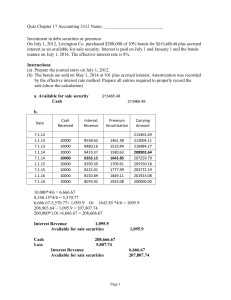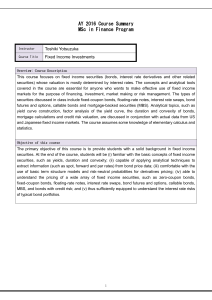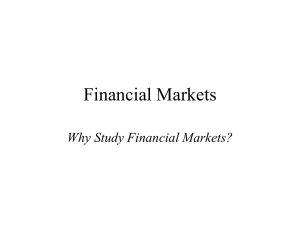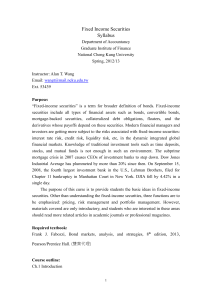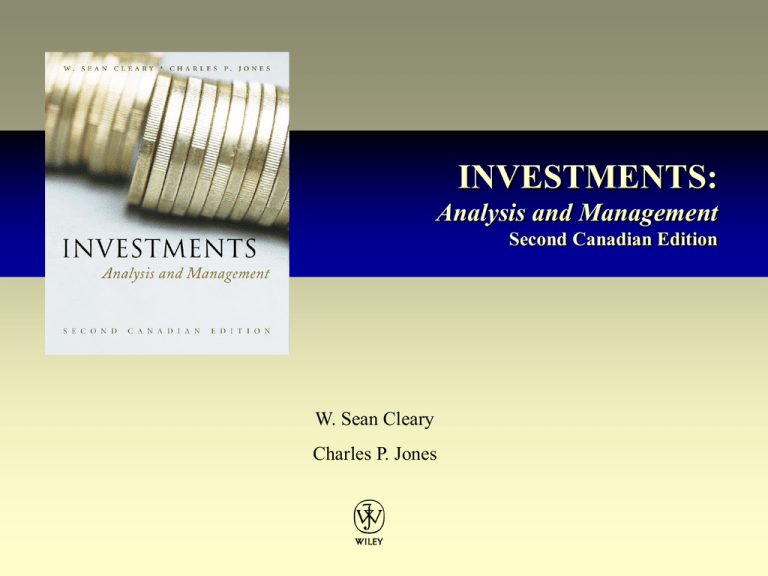
INVESTMENTS:
Analysis and Management
Second Canadian Edition
W. Sean Cleary
Charles P. Jones
Chapter 2
Investment
Alternatives
Learning Objectives
• Describe the major types of financial assets and
how they are organized.
• Explain what non-marketable financial assets are.
• Describe the important features of money market
and capital market securities.
• Distinguish among preferred stock, income trusts,
and common stock.
• Understand the basics of options and futures.
Non-Marketable Financial Assets
• Examples: Savings deposits, Canada Savings
Bonds (CSBs), Guaranteed Investment
Certificates (GICs)
• Commonly owned by individuals
• Represent direct exchange of claims between
issuer and investor
• Usually “safe” investments which are easy to
convert to cash without loss of value
Money Market Securities
• Examples: Treasury bills, commercial paper,
Eurodollars, repurchase agreements,
banker’s acceptances (B/As)
• Marketable: claims are negotiable or saleable
in the marketplace
• Short-term, liquid, relatively low-risk debt
instruments
• Issued by governments and private firms
Treasury Bills (T-bills)
• Treasury Bills:
Short-term promissory notes issued by
governments
T-bills accounted for about one-half of all
outstanding money market securities.
Sold at a discount from face value in
denominations of $5,000, $25,000, 100,000, and
$1 million
Typical maturities are 91, 182, and 364 days
although shorter maturities are also offered
Treasury Bills (T-bills)
• Treasury Bills:
Due to government backing, there is a very low
risk of default
Widely distributed and actively traded – high
liquidity
In subsequent chapters we will use government Tbill rates as a measure of the “riskless rate”
available to investors, commonly referred to as the
risk-free rate
Commercial Paper
• Commercial Paper:
Short-term unsecured promissory notes
issued by large, well-known, and financially
strong corporations (including finance
companies)
Denominations start at $100,000 with
maturities of 30 to 365 days, and it is sold
either directly by the issuer or indirectly
through a dealer, with rates slightly above Tbill rates.
Eurodollars
• Eurodollars:
Dollar-denominated deposits held in foreign
banks or in offices of Canadian banks located
abroad
Although this market originally developed in
Europe, dollar-denominated deposits can now
be made in many countries, such as those of
Asia
Consist of both time deposits and certificates of
deposit (CDs), with the latter constituting the
largest component of the Eurodollar markets
Maturities are mostly short-term, often less than
six months
Repurchase Agreements
• Repurchase Agreements (RPs):
agreements between a borrower and lender
(typically institutions) to sell and repurchase
money market securities
borrower initiates an RP by contracting to sell
securities to a lender and agreeing to
repurchase these securities at a pre-specified
(higher) price on a stated future date
maturity is generally very short, from 3 to 14
days, and sometimes overnight
minimum denomination is typically $100,000
Bankers Acceptances
• Bankers Acceptances (B/As):
Time drafts drawn on a bank by a customer,
whereby the bank agrees to guarantee
payment of a particular amount at a specified
future date
Differ from commercial paper because the
associated payments are guaranteed by a
bank, and thus possess the credit risk
associated with that bank
Issued in minimum denominations of $100,000
Typical maturities range from 30 to 180 days,
with 90 days being the most common
Fixed-Income Securities
• Marketable debt with maturity greater than one
year
• More risky than money market securities
• Fixed-income securities have a specified
payment schedule
Dates and amount of interest and principal
payments known in advance
Fixed-Income Securities
• Bonds – long-term debt instruments
• Major bond types:
Government of Canada bonds
U.S. Treasury bonds
Provincial bonds
Provincially-guaranteed bonds – Ontario Hydro
U.S. federal agency securities – GNMAs
(Ginnie Maes), FNMAs (Fannie Maes)
Fixed-Income Securities
• Major bond types (cont’d):
Corporate bonds
•
•
•
Usually pay semi-annual interest, are callable,
carry a sinking fund provision, and have a par
value of $1,000
Convertible bonds may be exchanged for
another asset
Risk that issuer may default on payments
Bond Characteristics
• Callable bonds give the issuer the option to
“call” or repurchase outstanding bonds at
predetermined “call” prices (generally at a
premium over par) at specified times
• This feature is detrimental to the bondholders
who are willing to pay less for them (i.e., they
demand a higher return) than for similar noncallable bonds.
• Generally, the issuer agrees to give 30 or more
days notice that the issue will be redeemed
Bond Characteristics
• Extendible Bonds: gives the investor an
option to extend the maturity date
• Retractable Bonds: gives the investor an
option to redeem the bond at par prior to
maturity
• Issuers are able to sell bonds with these
features at higher prices than straight issues
• When bond prices rise (yields fall):
they are attractive long-term investments
• When bond prices fall (yields rise):
they can trade as short-term debt
Bond Characteristics
•
•
•
Convertible Bonds may be converted into
common shares at predetermined prices.
This feature makes the issue more saleable and
lowers the interest rate that must be offered
Permits the holding of a two-way security:
•
•
The safety of a bond
The capital gains potential of a share
If the common shares of the company are split,
the convertible debt provides protection against
dilution by adjusting the conversion privilege
Convertibles are normally callable
Bond Characteristics
Convertible Bonds (cont’d)
• The market price of convertible debt depends
on the value of the underlying common stock
When the stock is selling well below the
conversion price, the convertible debt is more
like straight debt
When the stock approaches conversion price, a
premium appears
When the stock rises above the conversion
price, the debt will rise accordingly, and will
then be selling off the stock
Asset-Backed Securities
• Asset-backed securities are “securitized” assets
• E.g. mortgage-backed securities
Investors assume little default risk as most
mortgages are guaranteed by a federal
government agency
Equity Securities
• Represent an ownership interest
• Preferred stock
Preferred shareholders are paid after
bondholders but before common
shareholders
Dividend known, fixed in advance
May be cumulative if dividend omitted
Equity Securities
• Income trusts
Pay out a portion of cash flows generated from
underlying assets
E.g. royalty trusts and real estate investment
trusts (REITs)
• Common stock
Common shareholders are residual claimants
on income and assets
Common shareholders can elect board of
directors and vote on important issues
Derivative Securities
• Securities whose value is derived from some
underlying security
• Futures and options contracts are
standardized and performance is guaranteed
by a third party
Risk management tools
• Warrants are options issued by firms
Options
• Exchange-traded options are created by
investors, not corporations
• Call (Put) gives the buyer the right but not the
obligation to purchase (sell) a fixed quantity of
shares at a a fixed price before a certain date
• Options can be sold in the market at a price
• Increases return possibilities
Futures
• Futures contract: A standardized agreement
between a buyer and seller to make future
delivery of a fixed asset at a fixed price
A “good faith deposit” called margin, is required
of both the buyer and seller to reduce default
risk
Used to hedge the risk of price changes
Appendix 2-A
Taxation of Investment Income in Canada
• Interest income from debt securities is taxable
at the full marginal rate
• Dividends and capital gains afford investors a
tax break
Dividends received from Canadian
corporations are taxable for all provinces
except Quebec
Capital gain: only 50% is taxable
Copyright
Copyright © 2005 John Wiley & Sons Canada, Ltd. All rights
reserved. Reproduction or translation of this work beyond that
permitted by Access Copyright (The Canadian Copyright
Licensing Agency) is unlawful. Requests for further information
should be addressed to the Permissions Department, John Wiley
& Sons Canada, Ltd. The purchaser may make back-up copies
for his or her own use only and not for distribution or resale. The
author and the publisher assume no responsibility for errors,
omissions, or damages caused by the use of these programs or
from the use of the information contained herein.



